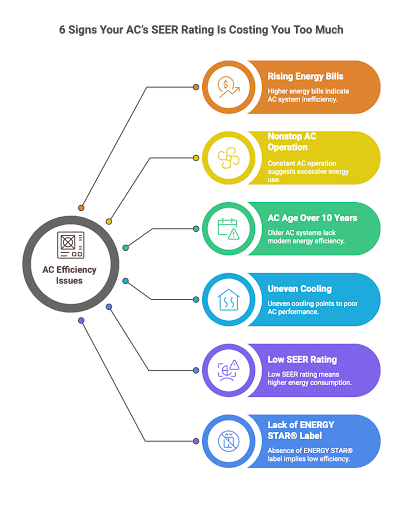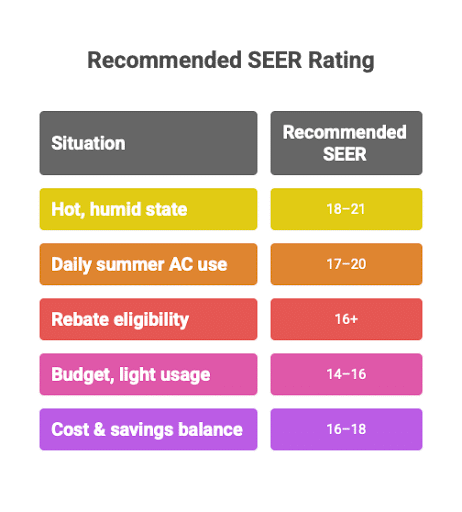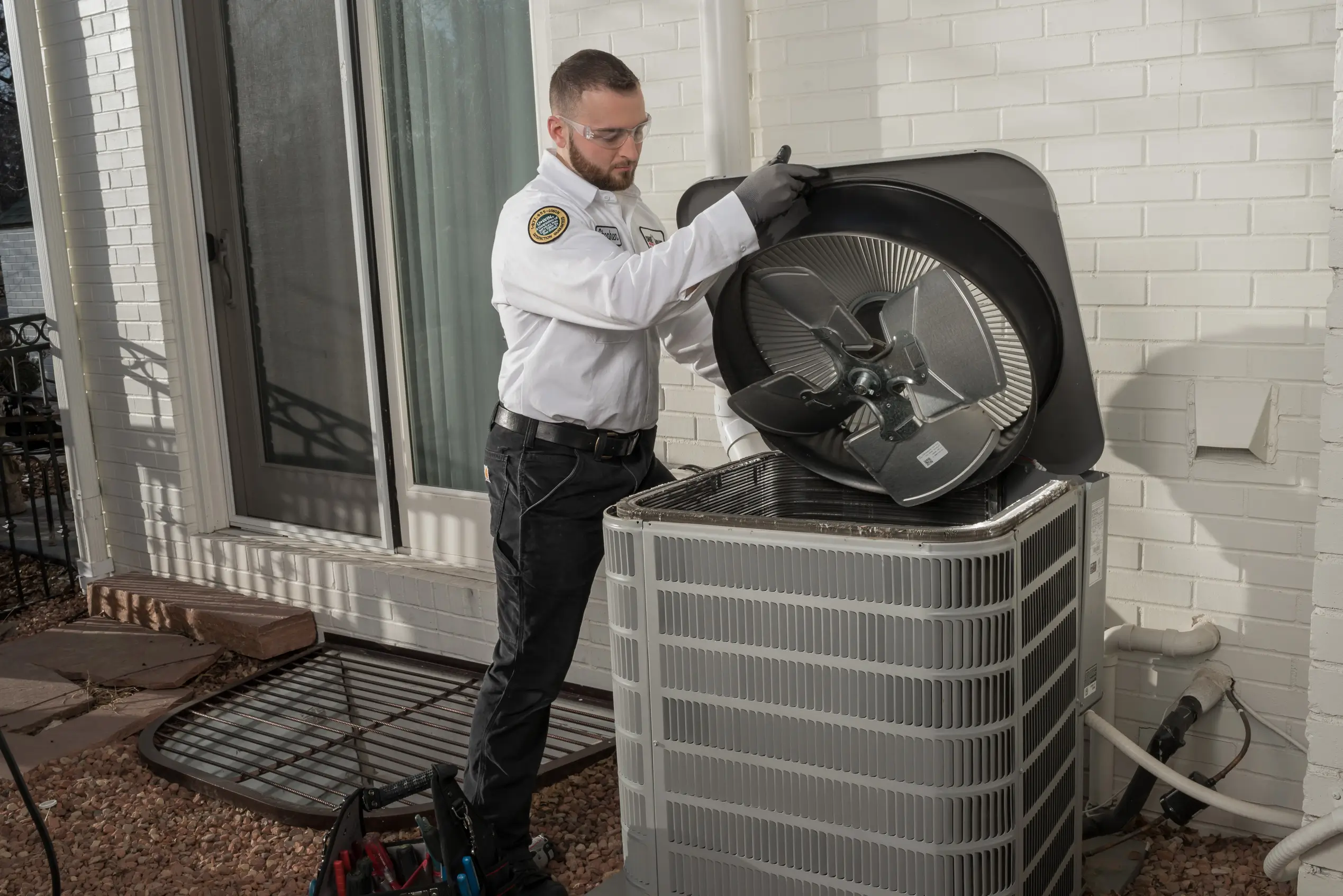June 30, 2025
Category: General,
Ever looked at your energy bill during summer and thought, “Why is this so high?”
You’re not alone. Each year, millions of U.S. homeowners crank up the AC as the temperatures rise — but never stop to think about how much energy their system is actually using. In fact, most people don’t even know what kind of air conditioner they have, let alone how efficient it is.
But here’s the thing: the SEER rating of your unit — a number hidden in plain sight — can make the difference between affordable comfort and sky-high electricity bills.
And in 2025, understanding that number isn’t optional anymore — it’s essential.
Why?
- Because energy prices keep rising.
- Because federal efficiency standards have changed.
- Because old systems cost more to run (even if they “work fine”).
- Because there are rebates and tax credits just for upgrading.
- And because the right SEER rating can save you hundreds — or thousands — over time.
The problem is: most people have no idea what SEER even means, how it works, or which number is actually “good.”
That’s what this guide is here to fix.
If you’ve been sweating your way through high bills, or thinking about upgrading your system, this is exactly what you need to read before making a move.
Let’s break down what is a good seer rating for an air conditioner.
First, What Is SEER Rating?
SEER stands for Seasonal Energy Efficiency Ratio. It’s the number that tells you how energy-efficient your AC is over an entire summer cooling season.
In simple terms: SEER = Total Cooling Output ÷ Total Electricity Used
It’s like MPG (miles per gallon) for your car:
- Higher SEER = Less electricity needed to cool your home
- Lower SEER = More electricity used, higher bills
Manufacturers include the SEER rating on every new unit, so you don’t have to calculate anything. You just need to know what the number means and what number makes sense for you.
Why Does the SEER Rating Matter?
It’s easy to overlook SEER, especially when price, size, or brand feel more important. But if you’re trying to be energy-smart, here’s why SEER is a big deal:
1. Lower SEER = Higher Energy Bills
Every time your AC kicks on, it draws power. Less-efficient systems use way more energy. That’s money down the drain.
2. High SEER = More Comfort
Systems with higher SEER ratings run more smoothly and maintain consistent indoor temperatures with fewer hot spots or humidity issues.
3. Energy Rebates
Units with SEER ratings above a certain level (usually 16+) often qualify for utility rebates or federal tax credits.
4. Higher Home Value
Buyers today look for efficient homes. An AC with a strong SEER rating adds to your home’s resale appeal.
So, What Is a Good SEER Rating for an Air Conditioner in 2025?
A good SEER rating for an air conditioner this summer is between 16 and 18.
This range gives you:
- Solid energy savings
- Good long-term performance
- Reasonable installation costs
- Eligibility for most rebates
Why 16 to 18 SEER Hits the Sweet Spot:
- It meets and exceeds new minimum U.S. standards
- It’s available in many brands and models
- It offers a good ROI within 5 to 7 years
- It doesn’t carry the high price tag of ultra-premium systems
Updated Federal SEER Standards (2023–2025)
The U.S. Department of Energy updated the minimum SEER requirements by region:
| Region | Minimum SEER |
|---|---|
| Northern States | 14 |
| Southern & Southwest | 15 |
If you live in:
- Texas
- Florida
- Arizona
- Southern California
…then your AC must meet at least 15 SEER. But if you’re buying new, don’t stop there — you’ll likely benefit from going up to 16–18.
Is a Higher SEER Rating Always Better?
This is a question we hear a lot. Is a higher SEER rating better?
The short answer: Yes — but only if it makes financial sense.
Here’s what a higher SEER gets you:
| SEER Rating | Energy Efficiency | Cost to Run | Upfront Cost | Best For |
|---|---|---|---|---|
| 13–15 | Basic | High | Low | Short-term renters, small spaces |
| 16–18 | Good | Medium | Medium | Most homeowners |
| 19–21 | High | Low | High | Hot climates, heavy AC use |
| 22+ | Premium | Very Low | Very High | Green homes, long-term investment |
The more hours you use your AC, the faster a high SEER unit will pay itself off.
How Much Can SEER Save You?
Let’s say your current system is 10 SEER (common in older homes).
You’re considering an upgrade to 16 SEER.
If you pay $1,200 per year to cool your home now:
- A 16 SEER system could cut that to $850/year
- That’s $350 savings per year
- Over 10 years = $3,500 saved
That’s real money — and it doesn’t include extra savings from rebates or maintenance.
Benefits of Higher SEER Ratings: Why It’s Not Just About Saving Money
Upgrading to a high-SEER air conditioner isn’t just about trimming your energy bill (though that’s a big part of it). The real value is in how it transforms your entire home comfort experience — quietly, efficiently, and reliably.
Here are the key advantages of choosing a system with a higher SEER rating, and why it matters more now than ever:
1. Lower Energy Bills
This is the most immediate and measurable benefit.
The higher your SEER rating, the less electricity your system uses to produce the same cooling effect. Over time, that adds up to hundreds, even thousands, in energy savings, especially if you live in a hot climate.
Example: Upgrading from a 10 SEER to a 16 SEER system can reduce cooling costs by 30–40% annually.
2. Improved Energy Efficiency
A higher SEER unit operates more efficiently, meaning it cycles on and off less frequently and uses power more intelligently.
Look for systems with:
- Variable-speed compressors
- Two-stage cooling
- Programmable thermostats
These features let your AC adjust its output based on your home’s current needs — not just blast cold air constantly. That means smarter cooling, less waste, and better long-term efficiency.
3. Greater Indoor Comfort
It’s not just about temperature, it’s how your space feels.
High-SEER systems improve:
- Humidity control
- Air distribution
- Temperature consistency between rooms
No more hot spots. No more muggy air. Just clean, even, quiet comfort.
Ductless mini-splits are a great example — they often have very high SEER ratings and allow room-by-room cooling, giving you full control over your comfort zones.
4. Quieter Operation
High-efficiency units are engineered to be quieter. Variable-speed motors and modern compressors eliminate that old-school “kick-on, roar, shut-off” cycle.
Instead, they run at lower speeds for longer periods, keeping noise to a minimum.
You might forget the AC is even running — until you notice how cool and quiet your home is.
5. Smaller Carbon Footprint
Less energy use = less environmental impact.
High-SEER systems are better for the planet, not just your wallet. By using less electricity, you’re reducing the demand on power plants — and lowering the carbon footprint of your household.
Want to go even greener? Look for:
- ENERGY STAR® certified units
- Units using R-410A refrigerant or newer low-impact alternatives
6. Longer System Lifespan
Because high-SEER units run more efficiently and cycle less frequently, they experience less wear and tear over time.
That means:
- Fewer breakdowns
- Longer equipment life
- Less stress on parts like compressors and fans
A well-installed high-SEER system, maintained properly, can easily last 15–20 years — especially when paired with a Comfort Club membership like we offer at One Hour Heating & Air Conditioning.
7. Higher Resale Value & Home Appeal
In today’s real estate market, energy efficiency matters. Buyers look for:
- Lower energy bills
- Modern systems
- Smart thermostats
- ENERGY STAR® ratings
A high-SEER system makes your home more attractive, marketable, and future-ready.

Tax Credits, Rebates, and Incentives for High SEER Units
Here’s something most homeowners don’t realize:
Upgrading to a high-efficiency AC unit with a better SEER rating doesn’t just lower your energy bills — it may also get you money back through federal tax credits, utility rebates, and state incentives.
Federal Tax Credits (Section 25C Credit)
Under the Inflation Reduction Act of 2022, homeowners can now claim up to $2,000 in federal tax credits for qualifying high-efficiency heat pumps and air conditioners.
To qualify, systems must:
- Meet ENERGY STAR® certification
- Have SEER2 ratings that meet or exceed federal minimums
- Be installed in a primary residence (not rental or vacation homes)
You’ll claim this through IRS Form 5695 as part of the Section 25C Energy Efficient Home Improvement Credit.
SEER2 Ratings & ENERGY STAR® Certification
In 2023, the HVAC industry shifted from the old SEER system to SEER2, a new testing method that reflects real-world performance more accurately.
To qualify for most rebates and tax incentives:
- Your unit must meet the minimum SEER2 requirement
- It must be labeled ENERGY STAR® certified or better
Examples of qualifying equipment:
- High-efficiency split ducted heat pumps
- Packaged gas/electric systems
- Variable-speed AC systems with SEER2 ≥ 16.0 (varies by region)
Always ask your installer if the specific model qualifies — not all 16-SEER systems are the same under SEER2 rules.
Local Utility Company Rebates
Many utility providers across the U.S. offer direct cash rebates for upgrading to a high-efficiency system.
These can range from $200 to $1,200+, depending on:
- Your SEER2 rating
- Whether you’re switching to a heat pump
- If you’re replacing an older system
- Your electric utility’s incentive program
You’ll often need:
- A certified installer
- A rebate application
- A detailed invoice with model numbers and efficiency ratings
Pro Tip: Ask your HVAC company to help you file — most reputable companies will handle it for you.
State and Regional Incentives
Depending on where you live, your state energy office or local environmental agency may offer additional rebates.
Some states offer:
- Sales tax exemptions on qualifying energy-efficient equipment
- Rebates up to $3,000 for whole-home heat pump installations
- Special incentives for low-to-moderate income households
Examples:
- California: Up to $3,000 in clean energy rebates for ducted heat pump systems
- Virginia: Certain areas offer bonus utility rebates for ENERGY STAR® central air systems
- Massachusetts: Offers Mass Save® rebates up to $10,000 for heat pump conversions
What to Look For When Shopping for Incentive-Eligible Units
When choosing a system, make sure it checks these boxes:
| Feature | Why It Matters |
|---|---|
| SEER2 Rating ≥ 16 | Required for many rebates |
| ENERGY STAR® Certified | Required for federal and local programs |
| Installed by Licensed Pro | Often required to qualify |
| Proper Documentation | Proof needed for rebates and tax credits |
What Is the Best SEER Rating for AC in Your Climate?
Here’s how to choose based on where you live in the U.S.:
Hot Climates (Texas, Florida, Nevada, Arizona)
- Heavy cooling use
- Best SEER: 18–21
Mild Climates (Pacific Northwest, Northeast)
- Light to moderate AC use
- Best SEER: 15–17
Rental or Short-Term Homes
- Budget matters most
- Best SEER: 14–16
What Is a Good HVAC SEER Rating Overall?
SEER applies to the cooling side of an HVAC system. If you’re upgrading your full HVAC setup, here’s what is a good hvac seer rating:
- A good HVAC SEER rating is 16 or higher
- Look for systems with:
- Variable-speed compressors
- Smart thermostats
- Energy Star® certification
These features add even more efficiency and comfort on top of the air conditioner seer rating.
Common Mistakes to Avoid When Choosing a SEER Rating
Don’t fall into these traps:
Only Looking at SEER
Efficiency is key — but make sure the system size, installation quality, and airflow design match your home.
Choosing the Highest SEER No Matter What
A 21 SEER system sounds great — until you realize it takes 12 years to break even in a mild climate.
Buying on Price Alone
The cheapest system usually ends up costing you more in repairs and energy over time.
Ignoring Rebates and Credits
Many homeowners leave $300–$2,000 in rebates on the table by not checking utility programs or federal tax credits.

So, What’s Your SEER Rating Really Costing You?
We get it — no one gets excited about air conditioning numbers. But when one number can quietly add $300–$1,000 to your energy bills every single year… it’s worth paying attention to.
Whether your AC is brand new or over 10 years old, its SEER rating tells a story — a story about how much energy it uses, how much comfort it delivers, and how much money it could be saving (or wasting).
And now that you know:
- What SEER means
- What a good air conditioner seer rating looks like (especially in 2025)
- Why higher isn’t always better
- And how SEER ties directly into performance, rebates, and long-term savings…
There’s really just one question left: Is your current system working for you… or against your wallet?
If you’re unsure, it’s not your job to figure it out alone — it’s ours.
At One Hour Heating & Air Conditioning, we help families across Hampton Roads make smart choices that match their homes, their budgets, and their long-term goals.
We’ve been proudly serving Coastal Virginia since 1979 as a family-owned and operated business. That’s over four decades of trusted repairs, reliable installations, and homes made more comfortable across the region from Virginia Beach to Newport News, Norfolk, Williamsburg, and beyond.
Whether you’re upgrading an old unit, building a new home, or just trying to understand your energy bills — we’re here to help.
Call us today at (757) 868-7600 or Contact Us to connect with our team today.

